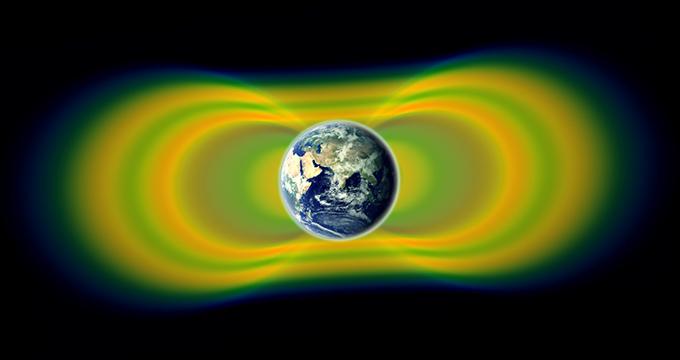Mystery radiation ring around the Earth catches scientists by surprise

The Van Allen radiation belt is supposedly composed of two torus-shaped layers of energetic charged particles (plasma) around the planet Earth, held in place by its magnetic field. The belt extends from an altitude of about 1,000 to 60,000 kilometers above the surface, in which region radiation levels vary. On Aug. 30, NASA launched the Radiation Belt Storm Probes mission, since renamed the Van Allen Probes mission, to learn more about the belts, which are known to be hazardous to satellites and astronauts. Each probe carries a Relativistic Electron-Proton Telescope, or REPT, designed and built at CU-Boulderís Laboratory for Atmospheric and Space Physics, known as LASP. When CU-Boulder scientists turned on the instruments, just a few days after launch, they were shocked by what they found: a third storage ring radiation belt.
It is generally understood that the inner and outer Van Allen
belts result from different processes. The inner belt, consisting
mainly of energetic protons, is the product of the decay of
so-called albedo neutrons which are themselves the result of cosmic
ray collisions in the upper atmosphere. The outer belt consists
mainly of electrons. They are injected from the geomagnetic tail
following geomagnetic storms, and are subsequently energized through
wave-particle interactions. The new third belt has no theory yet.

"It was so odd looking, I thought there must be something wrong with
the instrument," said LASP Director Dan Baker, REPT principal
investigator and lead author of the study published online today in
the journal Science. "But we saw things identically on each of the
spacecraft. We had to come to the conclusion that this was real."
The data sent back to Earth from the REPT instruments during the
month of September initially showed two Van Allen belts, as
expected. But after a few days, the outer ring appeared to compress
into an intense, tightly packed electron band and a third, less
compact belt of electrons formed further out, creating a total of
three rings. The middle storage ring persisted as the belt furthest
away from Earth began to decay away in the third week of September,
until, finally, a powerful interplanetary shock wave traveling from
the sun virtually annihilated both the storage ring and the rest of
the outer belt.
Scientists have known that the outer Van Allen belt can fluctuate
wildly, at times swelling with charged particles before letting them
slip away again, depending on space weather. In the months since the
storage belt and the outer belt virtually disappeared, the Van Allen
radiation zones have re-formed into the originally expected two-belt
structure.
"We have no idea how often this sort of thing happens," Baker said.
"This may occur fairly frequently but we didnít have the tools to
see it."
The fact that NASAís new tools observed the events at all was
somewhat serendipitous. When NASA launches a new spacecraft,
instruments onboard are turned on, tested and calibrated in a
prescribed order. CU-Boulderís REPT instruments were originally
scheduled to be turned on about a month after launch, when the third
Van Allen radiation belt would have already dissipated. But Baker
and his colleagues lobbied to jump the REPT instrument to the front
of the instrument commissioning line.
"Had we not done so, we would have missed this," Baker said. "Itís
good to be in the right place at the right time with the right
instrument."
The two NASA probes, which are flying around Earth in an elliptical
orbit, are able to send back observations for the first time from
the heart of the two belts as each probe passes through. The
information gathered by the twin, octagonal spacecraft will help
researchers better understand how space weather affects near-Earth
phenomena by interacting with, feeding and stripping away the Van
Allen belts.
A better understanding of belt formation, including the number of
belts, will help researchers refine their understanding of how and
when solar storms can wreak havoc on Earth.
"We can offer these new observations to the theorists who model
whatís going on in the belts," said Shri Kanekal, the deputy mission
scientist for the Van Allen Probes at NASAís Goddard Space Flight
Center in Greenbelt, Md. and a co-author of the new study. "Nature
presents us with this event ó itís there, itís a fact, you canít
argue with it ó and now we have to explain why itís the case. Why
did the third belt persist for four weeks? Why does it change? All
of this information teaches us more about space."
For further information see
Third Belt.
Van Allen Belt image via Wikipedia.
2013©. Copyright Environmental News Network